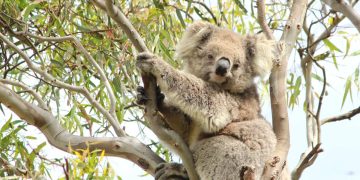This is part 1 in a series about providing water for wildlife to help them survive the heat.
[cover image of koala Zelda in the You Yangs by Mark Helle]
In southern Australia our summers are getting hotter and drier. The forecast for this summer 2025/26 is for much higher temperatures than average.
People suffer in these conditions, but we (mostly) have cool homes to retreat to, and plenty of water to drink. Imagine coping with those hot days without shelter or water?
This is the reality for wildlife, both in the urban areas and in the Bush.
One of the best ways to help them is to provide water. This article shows you how.
Our next article, part 2 in this series, will talk about what they need water for (its not just drinking!), how much they need, and how they prefer it, so that you can adapt to your unique circumstances.
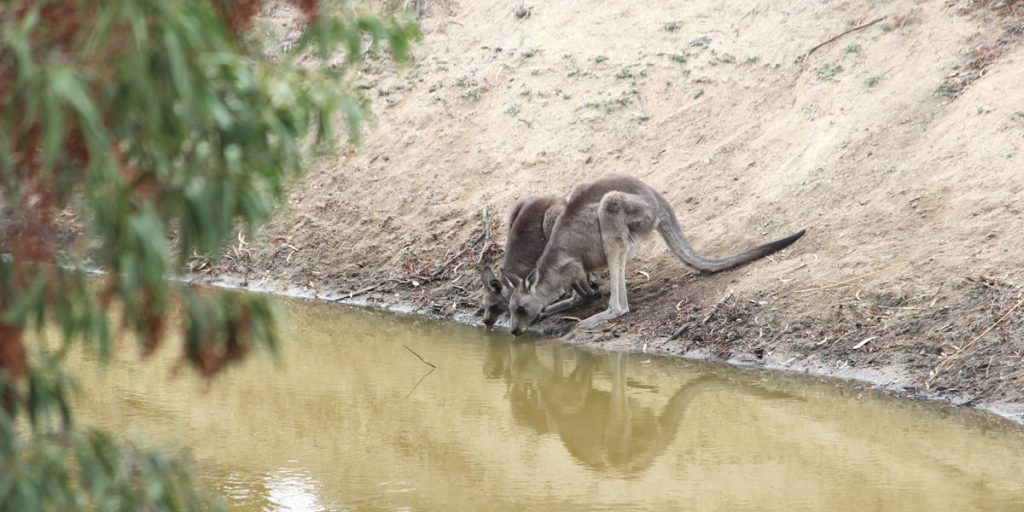
Lots of options, lots of water.
There’s no such thing as a perfect wildlife water station. Some creatures love the pedestal bird baths, others love a rubbish bin lid on the ground.
At Katherine, in the Northern Territory, I saw a very popular artificial water station, set up by Mick. He had a sprinkler on, beside a plastic chair with a pot saucer on it. The saucer had huge rocks taking up most of the surface. We watched in delight as Gouldian Finches, Star Finches, Brown and White-gaped Honeyeaters drank from the bird bath. Others preferred to just stand or fly under the sprinkler. Mick had set this one up specifically for small birds – by filling the shallow saucer with rocks, no big birds could dominate it for bathing. There was enough for everyone to have a drink. It was bedlam, and a birder’s idea of paradise.

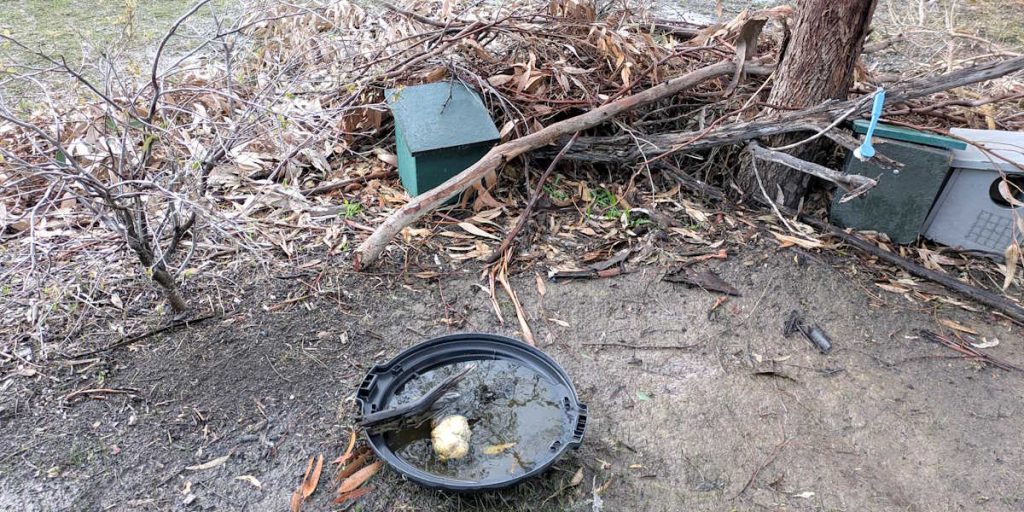
At my place, Staughton Vale in Victoria, Crimson Rosellas love an upturned rubbish bin lid on the ground at the base of a Manna Gum. They ignore the pedestal baths and hanging basins. They will perch in the Manna Gum until the time is right, then come down, walk around on the ground as happy as can be. They splash around in the water for ages. I just have a single rock in this one so they can stretch out.
Nearby I have a hanging basket containing a silver bowl, that is topped up by my nursery irrigation every day. Red Wattlebirds and Eastern Spinebills love this one! They perch up high on the rafters, and when they feel safe, they will dive in and splash around like crazy.

In the You Yangs, Vic, three oven trays under a Melaleuca in the base of a natural billabong are really popular. (Why oven trays? I don’t like plastic, they’re cheap, shallow, with a rounded lip and they last for ages.) I’ve watched Swamp Wallabies, an Echidna, a Brown Snake, Grey Fantails, Superb Fairy-wrens, Brown and Buff-rumped Thornbills, Spotted Pardalotes, Grey Shrikethrushes, Rufous Whistlers, New Holland, Yellow-faced and Brown-headed Honeyeaters, Eastern Spinebills visit, drink and bathe in these shallow pans.
The lesson here is that different creatures like different water stations. Why? It’s complicated, and our next article will explain some of the reasons.
The best option is to provide as many water stations as you can, as many different styles as you can.

Water everyday, and all year round
Not all wild animals need water every day, but making some water available every day is the best idea.
Birds need to bathe to keep their feathers in top condition (Tryjanowski 2022). A bath every day is ideal, even in winter.
Kangaroos and wallabies love to have a drink of clean, fresh water all year round. (Dawson 2006)

Koalas, Common Brushtail and Common Ringtail Possums might not need water every day, but they might take it if it’s available.
Watch koala “Clem” drink from a water trough outside our plant nursery: https://youtube.com/shorts/N3FE2ca7fZI (or see video embedded below)
Old, very young and sick animals need water more than healthy adults in their prime. They’re just like us really. If your system is a bit compromised or you’re growing rapidly, you need good food, water and shelter so that you can recover. Providing water all year round helps out the ones doing it tough.
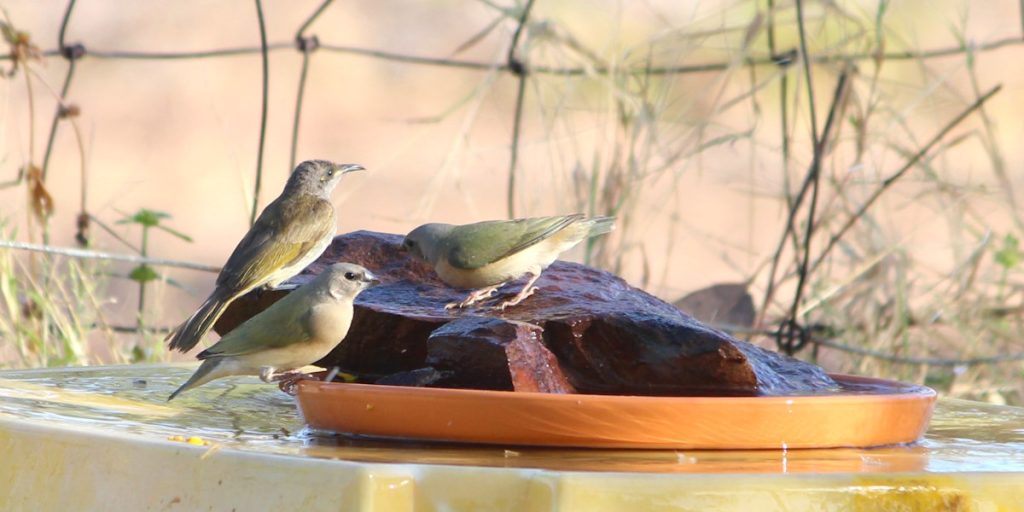
Let it dry out
A lot of people worry about letting their bird bath dry out. But it’s not such a bad thing, especially if you have many water stations at different levels of water. Best practice hygiene guidelines recommend letting your bird bath dry out fully. (Galbraith 2014)
Some harmful organisms live in permanently wet environments. Letting a shallow bird bath dry out completely, even for a day, will kill mosquito larvae and some of those organisms. A hot, dry surface exposed to the sun is a powerful disinfectant.
Permanent water attracts those animals that need a lot of water, including ferals and aggressive species. Big birds can guard bird baths. Water stations that dry out are less likely to attract unwelcome visitors, and they cater for different levels of water need.
I watched one of my water trays in the You Yangs one hot day, and was surprised to see no small birds nearby. Then I saw the Little Raven. She was perched in the tree above the water, guarding it for her family.

When the water is fresh, wide and deep, big birds will come and splash around. They need it too! As the water dries out to a few shallow puddles, the big birds leave – bathing is no longer possible for them. This is when the little birds get their only chance. As it dries out further, only tiny birds can get a beakful. Finally, when its nothing more than damp, butterflies, bees and other insects will enjoy it.
Wild animals are very tough, and accustomed to unreliable conditions. Australia is very prone to fluctuations, and our wildlife has developed mechanisms to cope. One or two days when they can’t access their favourite water bowl will not kill them, but a disease might.
I recommend that you provide one or two permanent water supplies, and three or four fluctuating shallow sources that dry out intermittently.
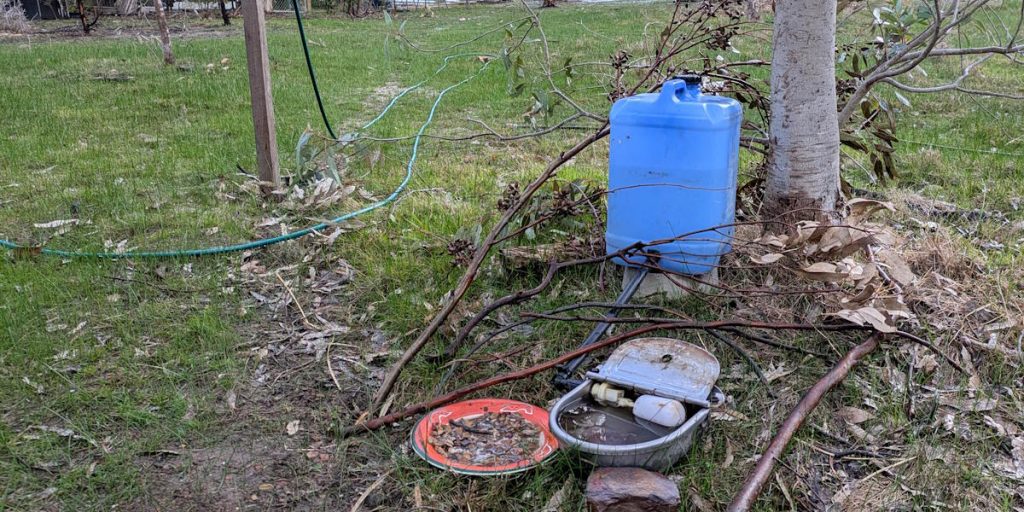
About keeping it clean
It is recommended that you clean your wildlife water supply regularly. But some types of artificial water don’t require cleaning, or are not practical to clean – like ponds and large troughs.
Animals drink from some pretty muddy, unhealthy places at times. But if you can clean your shallow basins and baths once a week, that’s brilliant. (Galbraith 2014)
There is a chance of spreading disease, if a diseased bird uses the water. In urban areas, the chance of this is probably higher. If you ever see a diseased bird* in your area, increase your efforts at bird bath hygiene – daily would be good in this situation.
To clean: scrub with a dishbrush, rinse, and spray with vinegar, then let it dry. Ideally, leave it for a day or two. Refill.
I recommend filling a spray bottle with cleaning vinegar (can be purchased cheaply from the cleaning aisle in supermarkets and hardware stores). Keep an old dish brush handy. If your water baths are near a tap, it’s much easier to do this regularly.
(note* diseased birds are often lacking feathers, or have strange-looking beaks)
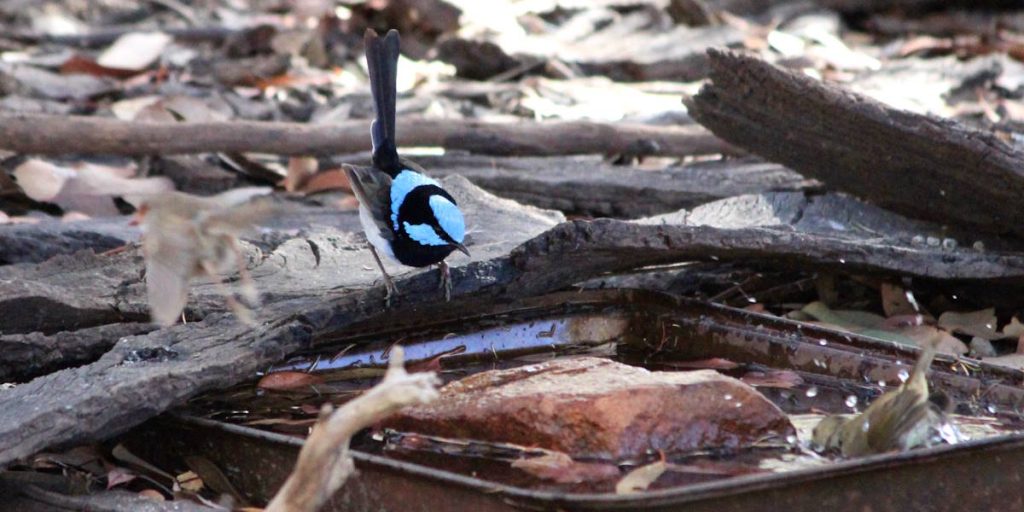
Give them time
You’ve created your wildlife water stations, and you’re as proud as punch. You keep looking out the window, or walking past to see who is using them. But nothing is happening! Maybe you’ve done something wrong?
Relax. There’s nothing wrong.
They will take time to find it – they might not visit your garden every day. Then they need to learn to include it in their routine.
Some will use it at night, or when no-one is home. TIP: if you have a wildlife camera, set it up near the water bath. You might be really surprised! (Members: we have a couple of wildlife cameras you could borrow, and we’d love to see how it goes!)
After a while they will come to know that water is often there, and may fly/hop/walk past to check. Then when the hot day comes, they’ll know where to go.
I recommend providing the water supply months before the hot weather starts – like now – and leaving it in the same place all year round. Then your wildlife neighbours will be ready when summer comes.
How to start
We have some self-filling Water for Wildlife kits available here.
You can reuse old plates or an oven tray, or buy some secondhand at an opp shop. Rubbish bin lids, kids play pools, pot saucers – all can be re-purposed into a wildlife water station. You’ll need a few rocks too. That’s it!
Please, let us know if you’ve acted on this! We will be thrilled to hear (and would love to see photos) of Water for Wildlife out there in the community. Click here to send us an email!
Thanks for caring!
Watch wild koala Clem drinking from a small trough outside our plant nursery in Staughton Vale, below. He drank for longer than this: 3 minutes and 19 seconds at least.
.
REFERENCES:
Dawson, T.J., McTavish, K.J., Munn, A.J. and Holloway, J., 2006. Water use and the thermoregulatory behaviour of kangaroos in arid regions: insights into the colonisation of arid rangelands in Australia by the Eastern Grey Kangaroo (Macropus giganteus). Journal of Comparative Physiology B, 176(1), pp.45-53. https://link.springer.com/article/10.1007/s00360-005-0030-2
Galbraith, J.A., Beggs, J.R., Jones, D.N., McNaughton, E.J., Krull, C.R. and Stanley, M.C., 2014. Risks and drivers of wild bird feeding in urban areas of New Zealand. Biological Conservation, 180, pp.64-74. https://www.sciencedirect.com/science/article/pii/S0006320714003553
(note the above article is about New Zealand birds, and primarily about feeding – but some of the considerations would apply to watering too).
Tryjanowski, P., Jankowiak, Ł., Czechowski, P., Dulisz, B., Golawski, A., Grzywaczewski, G., Indykiewicz, P., Kwieciński, Z., Mitrus, C., Nowakowski, J.J. and Polakowski, M., 2022. Summer water sources for temperate birds: use, importance, and threats. The European Zoological Journal, 89(1), pp.913-926. https://www.tandfonline.com/doi/abs/10.1080/24750263.2022.2101699
(note the above article is from Poland, and was conducted over summer.)



